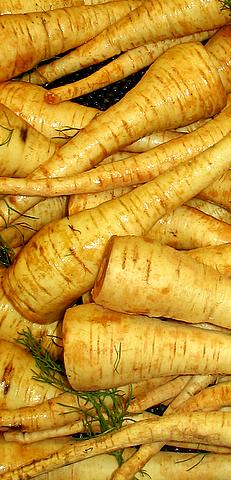
Parsnip (Pastinaca sativa) was once a food staple in Europe – during the Middle Ages – but fell out of favour when the Spanish introduced the potato in the second half of the 16th century. Consequently, the Latin name for parsnips is based upon pastus – meaning “food” – and sativa – meaning “cultivated”.
 Parsnips are related to carrots, which also belong to the family UMBELLIFERAE (now renamed Apiaceae), and both share a similar ‘umbel-shaped’ seed head seen in this diverse family, which includes angelica, anise, arracacha, asafoetida, caraway, carrot, celery, Centella asiatica, chervil, cicely, coriander/cilantro, cumin, dill, fennel, hemlock, lovage, Queen Anne's lace and various parsleys. (Source: Wikipedia).
Parsnips are related to carrots, which also belong to the family UMBELLIFERAE (now renamed Apiaceae), and both share a similar ‘umbel-shaped’ seed head seen in this diverse family, which includes angelica, anise, arracacha, asafoetida, caraway, carrot, celery, Centella asiatica, chervil, cicely, coriander/cilantro, cumin, dill, fennel, hemlock, lovage, Queen Anne's lace and various parsleys. (Source: Wikipedia).
Like carrots, parsnips develop a large tapered (creamy-white) root that can be used in stews, roasts, purees and soups.
Parsnips are planted out in autumn here on the warm Adelaide Plains and grown through winter. If left until the following Spring, they suddenly leap up to be two metres high and become a most attractive plant. As summer proceeds, the huge yellow flower umbels – like umbrellas in a wind storm – are pollinated by insects, most noticeably in our garden by green and gold ‘bottle-flies’ (Phaenicia sericata). The large central umbel is considered the best for seed production.


An alternative method is to cut the stem of the umbel and leave it to dry upside-down in a bucket, tapping the whole thing against the sides now and then to release the seed.




0 comments:
Post a Comment